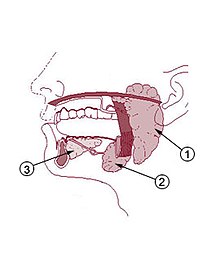Parotid gland
The parotid gland ( Latin parotid gland , also parotid gland or parotid for short ) is the largest salivary gland in the jaw and mouth area of higher vertebrates . It differs from the other oral salivary glands in its size, location and the composition of the saliva it produces.
location and size
In humans, the gland lies in front of and under the ear on either side of the face . It extends from the zygomatic arch to the angle of the jaw. It has a flat, triangular shape and a weight of 20-30 grams. It is surrounded by a connective tissue capsule ( fascia ), also known as the parotid compartment or fascia parotidea . Inside, it is divided into lobules by connective tissue. The gland cells located there produce a primary saliva , the composition of which changes on the way through the drainage system. Their excretory duct ( ductus parotideus , Stenon's duct) runs along the masticatory muscles ( musculus masseter ) and penetrates through the cheek muscle ( musculus buccinator ) and the cheek mucous membrane. The ending of the duct ( papilla parotidea ) in the oral cavity can be seen as a small dark point opposite the first to second upper molar .
The parotid plexus is located in the parotid and consists of fibers from the facial nerve (VII. Cranial nerve ). The fibers leaving the parotid plexus are responsible, among other things, for controlling the facial muscles in the face. In addition, the auriculotemporal nerve runs through the parotid , a sensitive nerve that comes from the posterior trunk of the mandibular nerve , which in turn comes from the trigeminal nerve . The auriculotemporal nerve gives off some parasympathetic fibers leading to the parotid (parasympathetic innervation through the glossopharyngeal nerve (IX) → " Jacobson's anastomosis ").
The external carotid artery also runs through the parotid and in this area is divided into its terminal branches, the maxillary artery and the superficial temporal artery . The parotid is supplied by the parotid branch of the posterior auricular artery. Blood drains through the parotid veins, which open into the retromandibular vein and finally into the internal jugular vein .
The lymph drainage occurs through the parotid lymph nodes .
Composition of parotid saliva
The parotid gland belongs to the purely serous glands. This means that the saliva it produces is purely liquid (watery) with no slimy ( mucous ) additive. The parotid saliva is therefore thin, slightly alkaline and rich in proteins and enzymes , especially amylase . This enzyme is used to break down carbohydrates . In addition, the parotid saliva contains immunoglobulins , which serve the immunological defense in the mouth.
Parotid diseases
Examination options of the parotid
- Palpation of the organ and the duct
- Ultrasonic
- Biopsy from the organ
- Gait representation with X-ray contrast medium as sialography
- Computed tomography
- NMR
Web links
- Mumps ( Memento from May 4, 2003 in the Internet Archive )
- Sjoegren Syndrome

